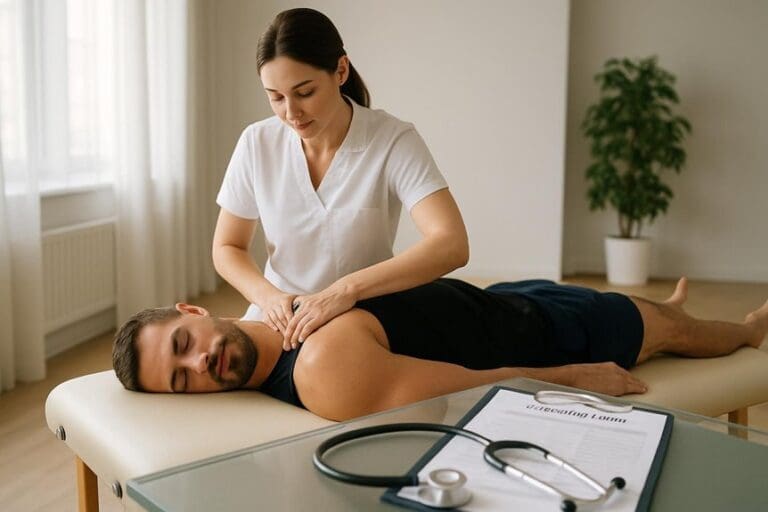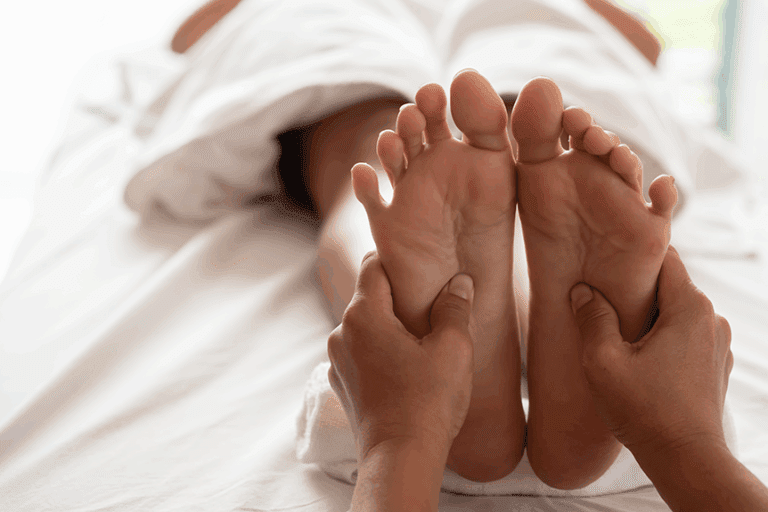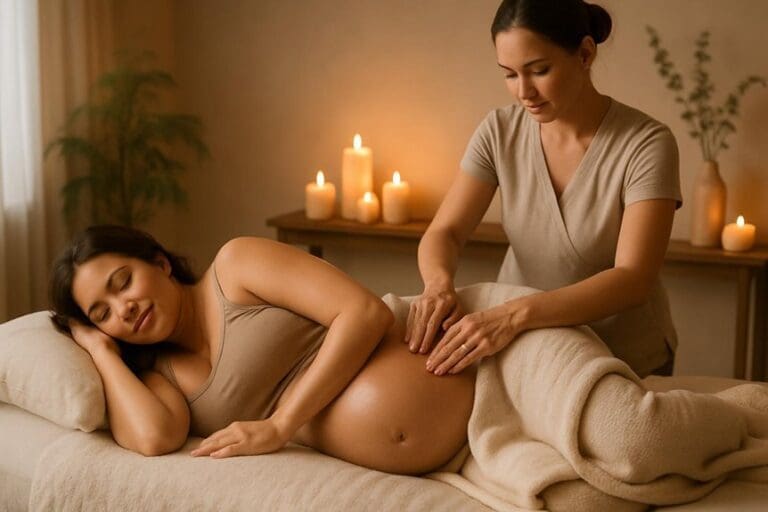This massage therapy is commonly a full-body treatment using diluted essential oils (1–3%) to support systemic relaxation. Sessions typically include back, shoulders, neck, legs, feet, arms, hands, chest, and often scalp or abdomen. Techniques use light-to-moderate pressure, slow effleurage, and gentle kneading to modulate autonomic tone and circulation. It can also be targeted for neck, lower back, or specific tension zones based on goals and contraindications. Oil selection is individualized for safety and effect. Further details clarify options and outcomes.
What an Aromatherapy Massage Typically Includes
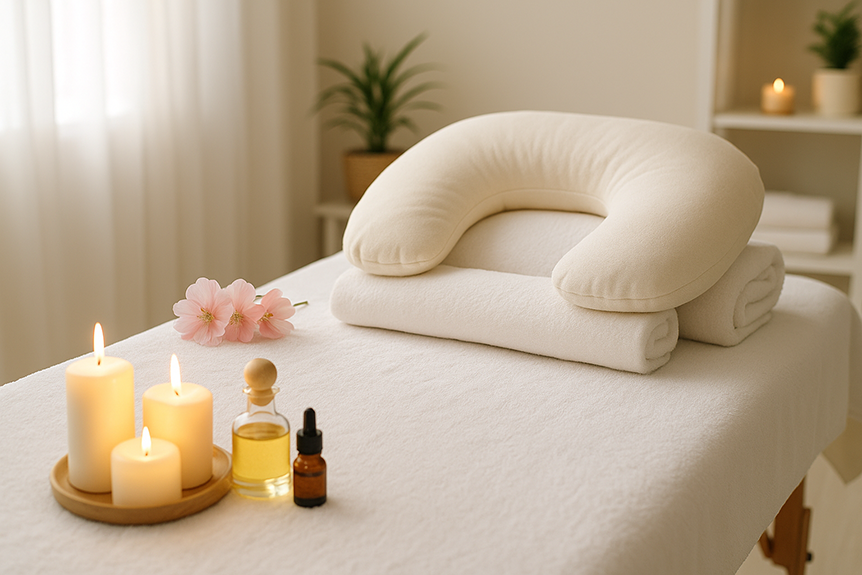
An essential oil massage typically includes a full-body manual treatment integrated with the controlled use of essential oils selected for their therapeutic properties and client goals.
At Spa & Massage, therapists begin with a concise consultation to clarify desired outcomes—calm, clarity, or muscle ease—screening for contraindications and sensitivities. Oils are diluted to evidence-based concentrations, typically 1%–3%, ensuring safety and olfactory comfort.
The session generally proceeds with a structured sequence: back, legs, feet, arms, hands, shoulders, neck, and scalp. Light-to-moderate pressure, rhythmic effleurage, and gentle kneading are used to enhance parasympathetic tone and circulation. Breathing cues are offered to deepen relaxation. Draping preserves warmth and modesty.
Aftercare includes hydration advice, gradual reactivation, and guidance on potential responses. Clients may request unscented carrier oil when preferred. Many clients choose aromatic massage to relax and heal with both the physical and emotional benefits that essential oils can provide.
Full-Body vs. Targeted Aromatherapy Sessions
A full-body aromatherapy session typically covers the back, legs, feet, arms, hands, neck, shoulders, and scalp, integrating inhalation and skin absorption for systemic effects.
At Spa & Massage, therapists recommend this format for generalized stress, sleep disruption, or whole‑system muscle tension, whereas targeted work is advised for localized issues such as neck stiffness, lower‑back discomfort, or repetitive‑strain areas.
Selection is guided by presenting symptoms, client goals, and evidence on regional vs. global outcomes, discussed during consultation.
What “Full-Body” Covers
Full-body aromatherapy at Spa & Massage typically includes the back, shoulders, neck, legs (front and back), feet, arms, hands, chest, and scalp, using blended essential oils selected to match the client’s goals. Coverage follows a structured flow to promote systemic relaxation and balanced circulation. Therapists use light-to-moderate pressure with rhythmic effleurage and gentle compressions, adjusting for sensitivity and desired intensity.
In our clinics, unscented carrier oils are combined with clinically referenced essential oils—often lavender for downregulation, eucalyptus for clearer breathing, or frankincense for grounding—while screening for contraindications.
Sessions often begin prone for back and legs, then supine for legs, arms, chest, neck, and scalp. Towelling preserves warmth and modesty, revealing only the area treated. The intent is all-encompassing nervous-system soothing, muscular ease, and a cohesive, intimate sensory experience.
When to Go Targeted
When does a targeted approach outperform a full-body session? Evidence and clinical practice suggest it is preferable when a client presents with localized pain, restricted range of motion, tension headaches, or postural strain. Focused aromatherapy allows higher precision: therapists at Spa & Massage pair condition-specific essential oils—such as lavender or chamomile for hyperarousal, eucalyptus for sinus-related pressure, and ginger or black pepper for muscular stiffness—with slow, sustained techniques to modulate nociception and reduce trigger-point irritability.
Targeted work is also advised during pregnancy for specific discomforts, or when time is limited and therapeutic goals are clear.
Full-body sessions remain valuable for systemic relaxation and sleep regulation. In our clinics, therapists assess symptoms, contraindications, and desired outcomes, then recommend session scope and oil blends to achieve measurable relief and intimate ease.
Areas Commonly Covered During a Full-Body Treatment
Standard full-body aromatic massage at Spa & Massage typically addresses the back, shoulders, and neck first, followed by legs (posterior and anterior), feet, arms, hands, chest, abdomen (optional based on client preference), and scalp.
The sequence is designed to modulate autonomic tone and improve tissue perfusion using measured pressure and paced breathing. In our clinics, therapists integrate slow effleurage with targeted kneading to distribute essential oil blends evenly while respecting client modesty and boundaries.
Back and neck work reduces paraspinal tension and primes the nervous system for deeper relaxation. Leg and foot techniques support circulatory return. Arm and hand strokes ease forearm fatigue from daily device use.
Chest and optional abdominal techniques are light and consent-led. A brief scalp sequence concludes, enhancing tranquility without overwhelming the senses.
When We Recommend Focusing on Specific Zones

Spa & Massage therapists often recommend concentrating aromatherapy techniques on targeted stress areas such as the neck, shoulders, jaw, and lower back, where muscle tension and sympathetic overactivity commonly cluster.
When there is a recent or historical musculoskeletal injury, they adjust pressure, select anti-inflammatory or calming essential oil blends, and coordinate with any clinical guidance to support tissue recovery.
This focused approach aims to reduce nociceptive input, improve circulation, and optimise functional comfort without aggravating sensitive structures.
Targeted Stress Areas
Three regions most often accumulate stress-related tension during daily life: neck and shoulders, lower back and hips, and forearms/hands. Evidence links prolonged sitting, screen use, and repetitive tasks to myofascial trigger points and sympathetic arousal in these zones.
In Spa & Massage clinics across London, therapists prioritise these areas during aromatherapy sessions when clients report headache, jaw clenching, lumbar fatigue, or typing strain.
Targeted work combines slow effleurage with focused kneading and gentle ischemic pressure, supported by essential oils selected for calming and muscle ease (commonly lavender, sweet marjoram, or rosemary, adjusted to sensitivity). Therapists modulate depth to maintain comfort and steady breathing.
Clients often notice warmer tissue, longer exhalations, and a softened neck base or sacroiliac area—markers of downregulated tension and restored ease.
Post-Injury Considerations
When is a full-body approach less appropriate after injury? In the acute phase (typically 48–72 hours), localized tenderness, swelling, or heat signals tissue reactivity; broad pressure risks aggravation. Spa & Massage therapists consequently prioritise specific zones, using gentle effleurage, lymphatic strokes, and low-intensity aromatherapy blends to modulate pain and reduce guarding.
Evidence supports regionally focused work that respects load tolerance and graded exposure principles.
They avoid direct pressure over unstable joints, suspected fractures, open wounds, or unassessed neurological symptoms, and request medical clearance when red flags appear.
In subacute stages, they layer targeted techniques—myofascial release, light trigger point work—around the injury, integrating distant areas (e.g., hip and thoracic spine for shoulder recovery) to restore patterns.
Oils are selected for comfort and sensitivity, with dosage cautiously titrated.
Essential Oils We Use and How They Influence Treatment
Although aromatherapy is often perceived as indulgent, the choice of essential oils is guided by pharmacological properties and client goals. At Spa & Massage, blends are selected for evidence-informed effects and dermal safety.
Lavender and roman chamomile are used for anxiolytic and mild analgesic actions, supported by small clinical trials. Eucalyptus and rosemary may aid respiratory ease and cognitive alertness; dilution mitigates sensitisation risk.
Sweet marjoram and ylang-ylang help downregulate sympathetic arousal, complementing slower, full‑body strokes. For muscular tension, black pepper and ginger promote local warmth and circulation, while frankincense supports paced breathing.
All oils are diluted in hypoallergenic carriers to 1–3% depending on body area and tolerance. Therapists document preferences, scent thresholds, and contraindications, aligning aroma profiles with therapeutic intent.
How to Personalise Your Session for Comfort and Results
Building on oil selection grounded in pharmacology and safety, personalisation focuses on measurable comfort and outcome goals.
At Spa & Massage, therapists begin with a brief structured intake: pain mapping, stress level rating, scent preferences, contraindications, and desired mood (calm, clarity, uplift).
Pressure is titrated using a 1–10 scale and adjusted region by region; many clients choose deeper work for shoulders and gentler strokes for the abdomen and inner arms to preserve a sense of intimacy.
Technique is matched to presentation: myofascial release for tension bands, lymphatic drainage for puffiness, and slower effleurage to downshift the nervous system.
Breathing cadence is coordinated with stroke rhythm for parasympathetic activation.
Therapists document responses and refine the blend, pressure, and pacing to meet clear, client-defined outcomes.
What to Expect at Our London Clinics
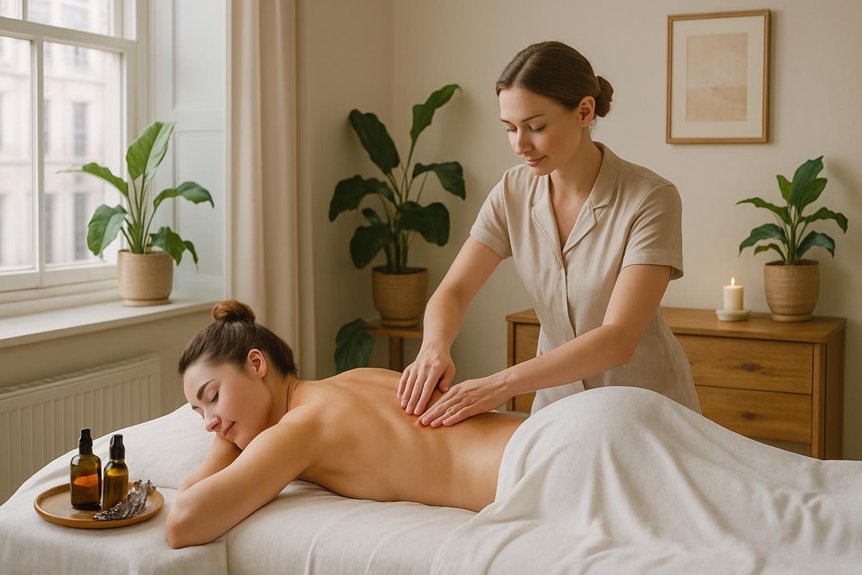
A visit to Spa & Massage’s London clinics begins with a quiet, scent-controlled reception and a brief structured intake to establish goals, contraindications, and scent/pressure preferences.
Clients are then escorted to a warm, low-light room where draping, consent, and fragrance options are reconfirmed.
Therapists at Crouch End, Bayswater, Chiswick, Earl’s Court, Belsize Park, and Richmond use medical-grade hygiene protocols and evidence-based aromatherapy blends, adjusting diffusion or carrier oils for sensitivity.
The full body session typically follows a head-to-toe sequence: back, legs, feet, arms, abdomen (optional), décolletage, neck, and scalp.
Pressure remains gentle to moderate, with targeted deeper techniques only where requested.
Communication is encouraged, but silence is respected.
The appointment concludes with measured reorientation time, hydration, and personalised guidance on scent tolerance and session frequency.
Aftercare Tips to Extend the Benefits
Following the structured full-body sequence and measured reorientation, aftercare focuses on sustaining parasympathetic balance, supporting tissue recovery, and optimising scent tolerance.
Spa & Massage recommends hydrating with 300–500 ml water within an hour, then sipping regularly. Clients should keep aromatic oils on the skin for 4–6 hours to prolong dermal absorption, avoiding hot showers that can strip lipids.
Light movement—slow walking, diaphragmatic breathing, and gentle neck–shoulder mobilisations—maintains circulation without overstimulation.
Their therapists advise a warm, protein-rich meal and magnesium-containing foods by evening to aid muscle repair.
Alcohol and intense training are best deferred for 12–24 hours.
Sleep hygiene matters: dim light, a cool room, and repeat inhalation of the session’s blend before bed.
For London-based continuity, Spa & Massage encourages scheduling follow-ups every 2–4 weeks.
Conclusion
In the end, aromatic massage functions like a well-orchestrated symphony: full-body when breadth is needed, targeted when a single instrument demands tuning. With carefully selected essential oils, safe dilution, and pressure tailored to presentation, the treatment aligns with evidence on touch, scent, and relaxation responses. Thoughtful draping, consent, and contraindication checks shape its boundaries. Clients leave with clear aftercare—hydration, gentle movement, rest—extending benefits beyond the table, like a calm current carrying relief through the hours that follow.

